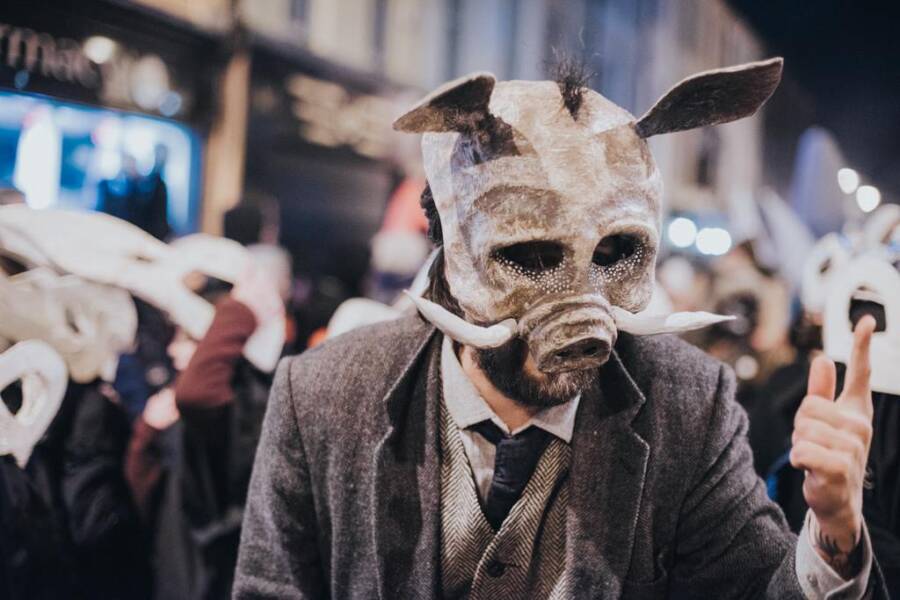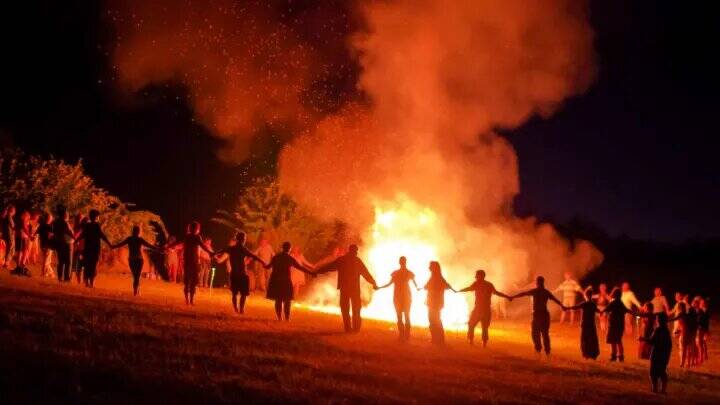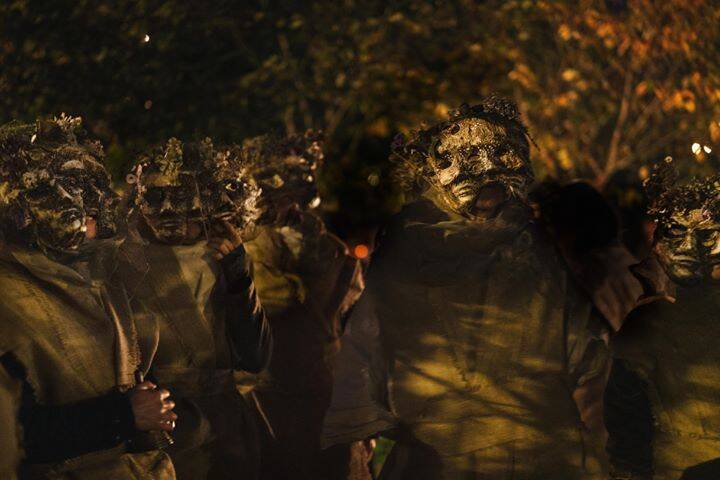Celebrated between October 31 and November 1, Samhain is a pagan harvest festival during which the spirits of the dead are said to walk among the living — and it inspired many of the Halloween traditions we practice today.

Samhain Festival/FacebookAttendees at a Samhain festival in Ireland.
Samhain, a word meaning “Summer’s End,” is a Celtic holiday marking the end of the harvest season and the beginning of the Celtic New Year on November 1. Originally celebrated among ancient Celts in Ireland, Wales, and Scotland over 2,000 years ago, the celebration was a time of elation and revelry when the veil between the living and the dead was thinnest.
The festivities lasted three days and three nights and involved lighting massive bonfires, holding banquets with copious amounts of food and alcohol, and connecting to the spiritual realm.
While Samhain is still celebrated among pagans in jubilant social gatherings across the globe, the holiday also directly inspired many of the Halloween traditions in practice today, including trick-or-treating and carving Jack-o-Lanterns.
Explore the vibrant rituals of this ancient Halloween predecessor in the gallery below.
The Ancient Origins Of Samhain
Although experts are not entirely sure where and when this pagan Day of the Dead holiday originated, there is evidence that ancient Celts in Ireland observed it over 2,000 years ago. Some Neolithic tombs in Ireland even align with celestial events that coincide with Samhain, suggesting its roots could go back as far as 4000–2500 B.C.E.
Ancient Celts believed the year was divided into two halves: the light and the dark. Samhain marked the end of the summer and the start of the colder, darker half of the year, which the Celts associated with death. As such, the festival was a time when the veil between the world of the living and the spiritual realm lifted, allowing fairies and the spirits of the dead to walk among the living. It also marked the end of the harvest season.
As one of four major Celtic holidays (Samhain, Imbolc, Beltane, and Lughnasadh), Samhain was immensely meaningful to the ancient Celts.
To honor the end of the harvest at Samhain, families would let their hearth fires burn out while they collected the last of the crops. Then, they would gather together for three days and three nights to celebrate.
According to some accounts of the festival, the community would meet to burn a large wheel built to represent the Sun in a ceremony led by Druid priests. Participants would then sacrifice animals in the fire and say prayers before lighting their torches with flames from the bonfire and carrying them back to their homes to light their hearths once more.
During this time, the Celts also reportedly hosted sumptuous feasts, communed with the dead, left out offerings for their ancestors, and dressed in creepy costumes to ward off evil spirits.

GL Archive/Alamy Stock PhotoAn artistic depiction of ancient Celtic Druids.
And while these celebrations were certainly jovial, Samhain rituals were also of sacred importance to the ancient Celts. Everyone was expected to participate in the festival or else face the wrath of the gods. In fact, the holiday demanded such reverence that anyone who committed crimes or drew their weapon at the festival could be sentenced to death.
Irish Folk Tales That Mention The Festival
During the Middle Ages, Christian monks began writing down Irish history and folklore, resulting in some of the earliest written accounts of Samhain.
In "Tochmarc Emire," one of the ancient stories preserved in the medieval Ulster Cycle collection, an Irish hero named Cú Chulainn goes on a quest to marry the woman of his dreams. In this tale, Samhain is mentioned as the first of four seasonal festivals.
In Irish mythology, magical beings like the Túatha Dé Danann or the sídh (fairies) were able to gain access to the physical world during Samhain. According to one legend, an evil fire-breathing deity named Aillen came to the human world during the festivities every year to burn down ceremonial structures — until the Irish folk hero Fionn mac Cumhaill slayed the evil being and restored peace on Samhain.

Wikimedia Commons / CC BY 3.0The entrance to the Cave of Cats.
It was said that these magical creatures entered the human world via various portals, the most famous being the Cave of Cats in Rathcroghan. In fact, many believe this cave to be the birthplace of Halloween over 2,000 years ago.
"Samhain was when the invisible wall between the living world and the otherworld disappeared," Rathcroghan-based researcher Mike McCarthy told National Geographic in 2023. "A whole host of fearsome otherworldly beasts emerged to ravage the surrounding landscape and make it ready for winter."
How Is Samhain Celebrated Today?

Beltane Fire SocietyA costumed participant in a Samhain festival.
For centuries, the Irish, Welsh, and Scottish celebrated Samhain by holding celebrations complete with food, bonfires, costumes, and communion with the dead. Over time, these Samhain traditions evolved and merged with Christian ones, eventually giving rise to Halloween.
Celtic families would often leave out food for the spirits during Samhain as an expression of goodwill. Sometimes, they would dress up as animals and monsters to trick spirits who might otherwise try to harm or kidnap them. It's said that these Samhain rituals inspired the modern Halloween tradition of trick-or-treating.
Even the tradition of carving Jack-o-Lanterns is rooted in Samhain. Beginning around the Middle Ages, revelers would hollow out turnips and other root vegetables to use as lanterns, carving creepy faces into them to scare off evil spirits.

Carnegie Museum of Natural HistoryA turnip lantern, the precursor to the Jack-o-Lantern, from the early 20th century in Ireland.
Samhain is still celebrated around the world today. The holiday can be observed in solitude in one's home, or through large festivities as the ancient Celts once enjoyed.
For solitary observers, Samhain is a time for holding feasts and honoring ancestors. One example of this is "dumb supper," a practice in which participants cook a memorial dinner, often featuring the favorite foods of their departed loved ones, and invite the spirits of the dead to join them in a silent meal. Solitary observers may also create altars and practice divination.
For those interested in celebrating with others, some of the best places in the world to observe Samhain are, unsurprisingly, in Ireland.
Every year, the city of Derry in Northern Ireland holds a massive Samhain street party. Considered the largest Halloween festival in Europe, the four-night celebration attracts some 100,000 people each year for parades, music, performances, food, and fireworks.
Likewise, various neopagan celebrations around the world involve large bonfires, dancing, and other Samhain rituals that are reminiscent of the way ancient Celts first celebrated the holiday thousands of years ago.
After reading about Samhain, dive into the history of Yule, the pagan holiday that celebrates the Winter Solstice. Then, read about 26 of the world's most bizarre festivals.







































